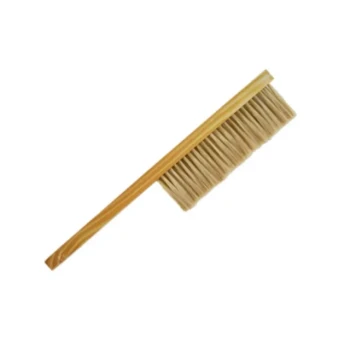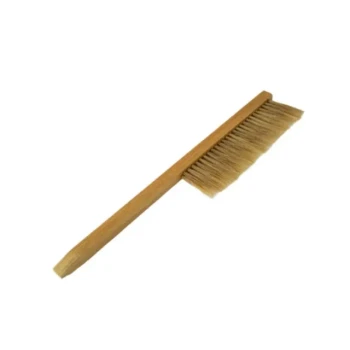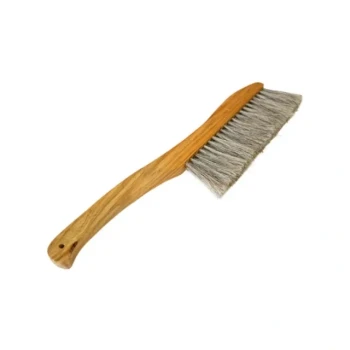For managing a beehive, a brush is not an effective alternative to a smoker. A brush is a tool for a different, very specific purpose: physically removing a small number of bees from a frame. Using it aggressively or on a large scale tends to agitate the colony, making the bees angry and defensive, which is the opposite of a smoker's intended effect.
The core issue is one of purpose versus outcome. A smoker calms a colony by masking alarm pheromones, enabling a safe inspection. A brush physically displaces bees, which often provokes the very defensive reaction you want to avoid.
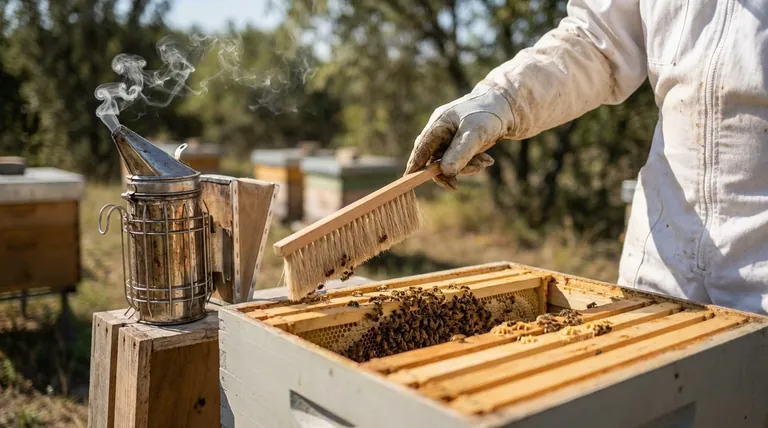
Why Smoke is the Standard Tool
A smoker is the most trusted tool for calming a honeybee colony because it works with their biology, not against it. Understanding this is key to understanding why other methods fall short.
How Smoke Actually Works
Smoke's primary function is to mask the bees' alarm pheromones. When a bee feels threatened, it releases these chemical signals to alert the rest of the hive to a danger. Smoke overwhelms these signals, preventing a chain reaction of defensiveness from spreading throughout the colony.
The Goal of Calm Management
By interrupting their main communication channel for danger, the smoker allows the beekeeper to inspect the hive without causing widespread panic. This makes the process safer and less stressful for both the beekeeper and the bees.
The Role and Limitations of a Bee Brush
A bee brush has a valuable, but narrow, role in beekeeping. Confusing its purpose with that of a smoker is a common mistake for beginners.
The Intended Use of a Brush
A brush is designed for gently flicking a few lingering bees off a frame of honey right before you take it for extraction. In this limited context, where you are removing the frame from the hive area entirely, it is effective.
Why Brushing Annoys Bees
Unlike smoke, which is an indirect environmental cue, brushing is a direct physical action. It is interpreted by the bees as an attack or a major disturbance, which naturally triggers a defensive response.
The Risk of Escalation
When you anger bees with a brush, they release alarm pheromones. Without smoke to mask these signals, the defensiveness can quickly spread, turning a calm hive into an agitated one and increasing the likelihood of stings.
Understanding the Trade-offs
While some beekeepers prefer to avoid smoke, it's critical to recognize the limitations of the alternatives.
Efficacy: Smoke vs. Alternatives
Alternatives like water mists with essential oils (lavender, lemongrass) or liquid smoke exist, but they are not considered as consistently effective as a traditional smoker. Their calming effects can be less reliable and vary between colonies.
The Problem with Scent-Based Alternatives
The bee colony relies heavily on complex scent cues for communication. While essential oils may have a calming effect, their long-term impact on the hive's internal communication and health is not fully understood. They are powerful substances that should be used with caution.
The Need for a Backup
Even beekeepers who experiment with smoke-free methods acknowledge the risks. The most responsible practice is to always have a smoker and fuel nearby and ready to use in case an alternative method fails and the hive becomes dangerously defensive.
How to Apply This to Your Hive
Choosing the right tool depends entirely on your specific goal during a hive interaction.
- If your primary focus is a safe, calm, and complete hive inspection: A smoker is the correct and most reliable tool for the job.
- If your primary focus is clearing the last few bees from a single frame of honey away from the hive: A brush is perfectly suited for this specific task.
- If your primary focus is to practice smoke-free beekeeping: Experiment cautiously with alternatives like water mists, but always keep a smoker on hand as a critical safety backup.
Ultimately, using the right tool for the right job is the foundation of effective and responsible beekeeping.
Summary Table:
| Tool | Primary Purpose | Effect on Bees | Best Use Case |
|---|---|---|---|
| Smoker | Calm the colony | Masks alarm pheromones, prevents defensiveness | Safe, complete hive inspections |
| Bee Brush | Physically move bees | Can agitate and provoke defensive stings | Gently clearing bees from a single honey frame |
Ensure your apiary operations are safe and efficient with the right tools from HONESTBEE.
We supply commercial apiaries and beekeeping equipment distributors with high-quality, reliable smokers and other essential beekeeping supplies through our wholesale-focused operations. Equip your business with the best to protect your bees and your productivity.
Contact HONESTBEE today to discuss your wholesale supply needs.
Visual Guide
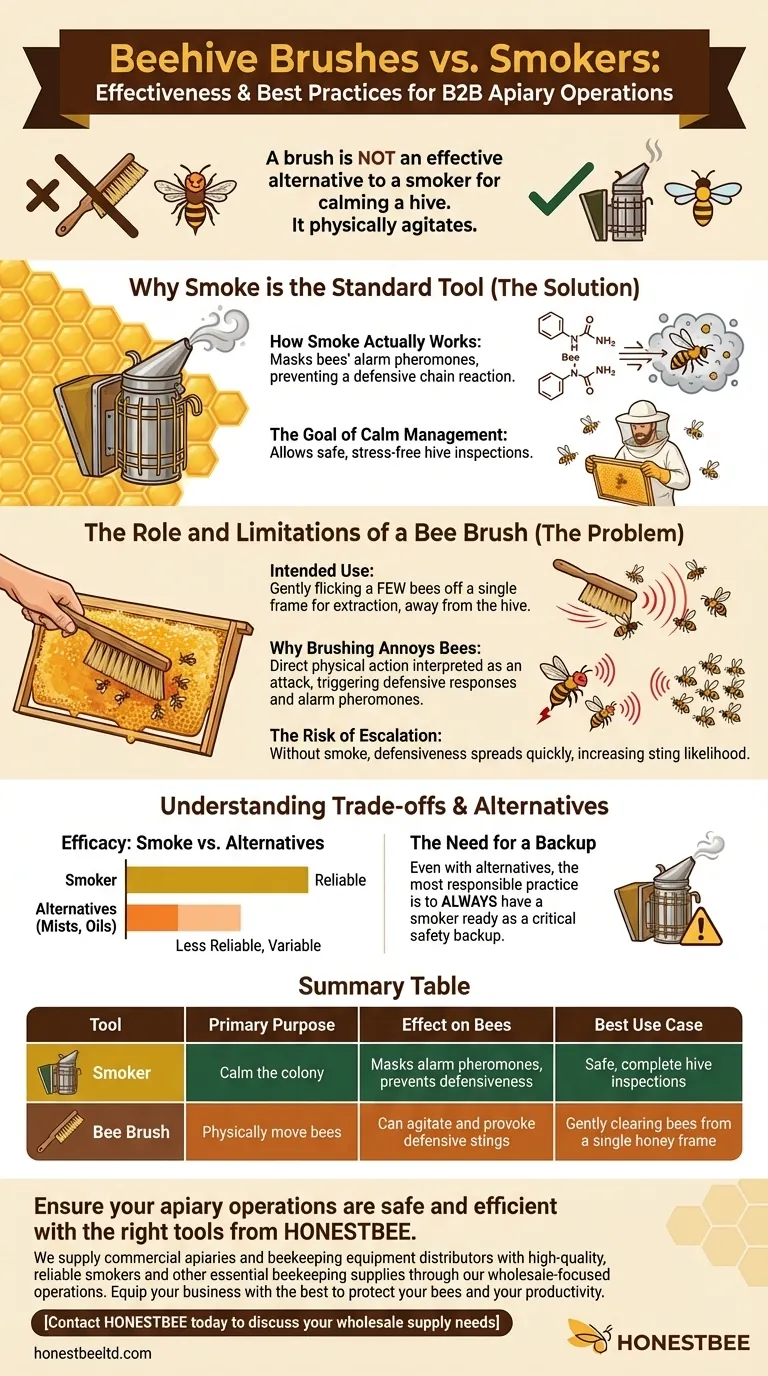
Related Products
- Wooden Bee Brush with Double-Row Horsehair Bristles
- Plastic Handle Single Row Artificial Fiber Bee Brush
- Wooden Bee Brush with Triple Row Artificial Fiber for Beekeeping
- Double Row Artificial Fiber Bee Brush for Beekeeping
- Classic Wooden Bee Brush with Double-Row Boar Bristles
People Also Ask
- What are the characteristics of the bristles on a bee brush? Designed for Gentle Persuasion, Not Force
- What is a bee brush and how is it used in beekeeping? A Guide to Gentle Bee Handling
- What are some optional tools that can be useful in beekeeping? Boost Efficiency & Hive Health
- What should be done if the swarm is situated on the bottom of a tree limb? A Guide to Methodical Bee Capture
- How is a bee brush used in beekeeping? Master Gentle Bee Handling for Your Apiary



